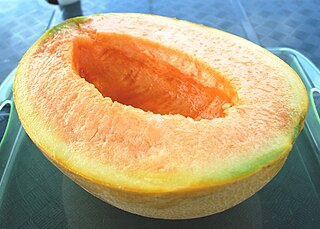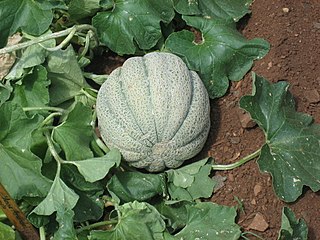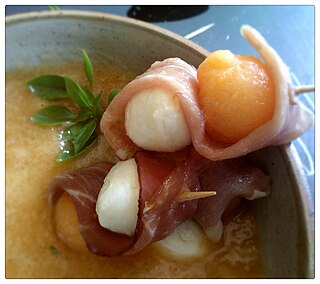Related Research Articles

The cantaloupe is a type of food; a true melon from the family Cucurbitaceae. Originally, cantaloupe referred only to the non-netted, orange-fleshed melons of Europe, but today may refer to any orange-fleshed melon of the C. melo species, including the netted muskmelon which is called cantaloupe in North America, rockmelon in Australia and New Zealand, and spanspek in Southern Africa. Cantaloupes range in mass from 0.5 to 5 kilograms.

A melon is any of various plants of the family Cucurbitaceae with sweet, edible, and fleshy fruit. The word "melon" can refer to either the plant or specifically to the fruit. Botanically, a melon is a kind of berry, specifically a "pepo". The word melon derives from Latin melopepo, which is the latinization of the Greek μηλοπέπων (mēlopepōn), meaning "melon", itself a compound of μῆλον (mēlon), "apple", treefruit " and πέπων (pepōn), amongst others "a kind of gourd or melon". Many different cultivars have been produced, particularly of cantaloupes.

Johanna Maria Lind (Madame Goldschmidt) (6 October 1820 – 2 November 1887) was a Swedish opera singer, often called the "Swedish Nightingale". One of the most highly regarded singers of the 19th century, she performed in soprano roles in opera in Sweden and across Europe, and undertook an extraordinarily popular concert tour of the United States beginning in 1850. She was a member of the Royal Swedish Academy of Music from 1840.

The Montreal melon, also known as the Montreal market muskmelon or the Montreal nutmeg melon, is a type of melon traditionally grown in the area around Montreal, Canada. It was popularised by the seed merchant W. Atlee Burpee starting in 1881 but later disappeared from large-scale cultivation. It was rediscovered in 1996 in a seed bank in Iowa.

Horchata, or orxata, is a name given to various beverages, which are generally plant based, but sometimes contain milk. In Spain, it is made with soaked, ground, and sweetened tiger nuts. In some parts of the Americas, the base is jicaro, melon or sesame seeds, or white rice, along with other spices. Different varieties can be served hot or cold, and may be used as a flavor in other beverages, such as frappé coffee.

The honeydew melon is one of the two main cultivar types in Cucumis melo Inodorus Group. It is characterized by the smooth, often green or yellowish rind and lack of musky odor. The other main type in the Inodorus Group is the wrinkle-rind casaba melon.

The Hami melon is an umbrella term for sweet melon varieties from Xinjiang, China, especially from Hami. It is also referred to as the Chinese Hami melon or the snow melon. The outer color is generally white through pink or yellow through green. The inside flesh is sweet and crisp.
Southern Exposure Seed Exchange (SESE) is a cooperatively-owned seed company based out of Mineral, Virginia. SESE is a source for heirloom seeds and other open-pollinated (non-hybrid) seeds with an emphasis on vegetables, flowers, and herbs that grow well in the Mid-Atlantic region. SESE also supports seed saving and traditional seed breeding through their product line, through lectures and workshops, and by working with over 50 small seed-growing farmers in the Mid-Atlantic and other parts of the United States. SESE publishes an intermittent email newsletter and blog for gardeners, as well as the Southern Exposure Seed Exchange Catalog and Garden Guide.
Jenny Lind was a Swedish opera singer.
Melon ballers are utensils to make balls of melon from a scoop with a diameter from around 1 centimeter to 3 centimeters. They are generally used to make fruit salad.

Amy Goldman Fowler is an American billionaire heiress, gardener, author, artist, philanthropist, and advocate for seed saving and heirloom fruits and vegetables. She is one of the foremost heirloom plant conservationists in the US. Goldman has been called "perhaps the world's premier vegetable gardener" by Gregory Long, president emeritus of The New York Botanical Garden.

The Yubari King is a cantaloupe cultivar farmed in greenhouses in Yūbari, Hokkaido, a small city close to Sapporo.

Cucumis melo, also known as melon, is a species of Cucumis that has been developed into many cultivated varieties. The fruit is a pepo. The flesh is either sweet or bland, with or without a musky aroma, and the rind can be smooth, ribbed, wrinkled, or netted. In North America, the sweet-flesh varieties are often collectively called muskmelon, including the musky netted-rind varieties and the inodorous smooth-rind varieties, and cantaloupe usually refers to the former type. However, muskmelon in a narrow sense only refers to the musky netted-rind type, also known as North American cantaloupe, while the true cantaloupe is the European type with ribbed and often warty rind that is seldom grown in North America.

The 2011 United States listeriosis outbreak was a widespread outbreak of Listeria monocytogenes food poisoning across 28 US states that resulted from contaminated cantaloupes linked to Jensen Farms of Holly, Colorado. As of the final report on August 27, 2012, there were 33 deaths and 147 total confirmed cases since the beginning of the first recorded case on July 31, 2011. It was the worst foodborne illness outbreak in the United States, measured by the number of deaths, since the Centers for Disease Control and Prevention began tracking outbreaks in the 1970s, or tied with the worst, an outbreak of listeria from cheese in 1985, depending on which CDC report is used.

The Crane Melon is an heirloom melon developed by Oliver Crane in the early 20th century in Penngrove, California. It is grown and sold at specialty grocery stores and farmers markets and was first available from the Crane Melon Barn in Santa Rosa, California.

A Charentais melon is a type of French cantaloupe, Cucumis melo var. cantalupensis.

Melon soup is a soup prepared with melon as a primary ingredient. Melons such as bitter melon, cantaloupe, crenshaw melon, honeydew and winter melon may be used, among others. Some melon soups are prepared with whole pieces of melon, and others use puréed melon. Some are served hot, while others are served chilled. Some cold varieties are prepared without any cooking involved. Several styles and varieties of melon soups exist, including bitter melon soup, cantaloupe soup and winter melon soup, among others. The origin of some melon soup recipes may cross international boundaries.

Samalamig, also known as palamig, is a collective term for various Filipino sweet chilled beverages that usually include jelly-like ingredients. They come in various flavors, and are commonly sold by street vendors as refreshments. Typical ingredients of the drinks include gulaman (agar), sago pearls, kaong, tapioca pearls, nata de coco, and coconut. They are usually anglicized as pearl coolers or pearl and jelly coolers.
The banana melon is an heirloom melon in the genus Cucumis originating from around 1880 in the United States.
References
- 1 2 Childs, Danny (2022-07-18). "The Story of the Long-Forgotten Jenny Lind Melon". Modern Farmer. Retrieved 2023-09-30.